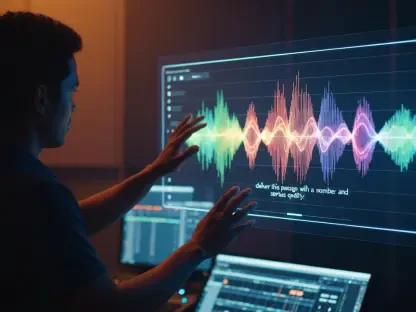In the rapidly evolving world of web development, staying ahead of the curve is more crucial than ever. As technology advances and user expectations shift, businesses must constantly adapt to the latest trends to remain competitive. Failing to do so can result in losing potential customers and significant revenue. By 2025, several key trends are expected to dominate the industry, and understanding these will be essential for any business looking to succeed in the digital space.
The importance of keeping up with web development trends cannot be overstated. The web design and development market is continually expanding, with substantial increases in market valuation and a forecasted compound annual growth rate of 10.2% from 2024 to 2031. This growth reflects the broader shift toward digital-first strategies. Businesses that fail to adapt risk obsolescence, while those that do can leverage these trends to attract and retain customers effectively.
Customized Visuals
In a digital market that grows more crowded by the day, standing out becomes a crucial objective for any business. One major trend for 2025 is the move away from generic stock imagery toward customized visuals. Instead of relying on standardized images that can make a website look like countless others, brands will find it increasingly important to create bespoke visual content that accurately reflects their identity. Customized visuals not only enhance user engagement but also simplify navigation and make content more accessible. This approach fosters a deeper connection with users and has the potential to drive more conversions through a personalized experience.
The trend toward customized visuals also opens the door for greater creativity in website design. Designers will have more freedom to align visual elements closely with a brand’s ethos, resulting in a cohesive and compelling online presence. Unique visuals leave a lasting impression on visitors and can significantly reinforce brand recognition and loyalty. As users continue to seek more personalized and unique online experiences, the importance of customized visuals will only grow. This trend can make a substantial difference in how businesses present themselves, providing a unique edge in the competitive digital landscape.
Mobile-First Design
The importance of mobile-first design cannot be overstated as we approach 2025. Over half of global web traffic now originates from mobile devices, making it crucial for businesses to optimize their websites for smaller screens. Mobile-first design prioritizes the mobile user experience, ensuring fast load times and intuitive navigation. This approach not only improves user engagement but also retention, as users are more likely to stay on a site that functions seamlessly on their devices. Websites designed with a mobile-first mindset are more likely to engage users effectively, thereby increasing the likelihood of conversion and customer satisfaction.
Moreover, search engines like Google prioritize mobile-friendly websites in their rankings, meaning that businesses adopting mobile-first design can benefit from improved visibility and higher search engine rankings. This trend is about more than just resizing content; it involves rethinking website functionality to ensure that all elements are accessible and user-friendly on mobile devices. An optimized mobile experience is now a necessity rather than an option, making it an indispensable aspect of modern web development.
Dark Mode
Dark mode has rapidly become a staple in modern web design, and its popularity is only expected to grow by 2025. Offering both aesthetic appeal and practical benefits, dark mode reduces eye strain in low-light environments and can save battery life on OLED screens. As more users express a preference for dark mode, many websites are adopting it as a standard feature. Implementing dark mode significantly enhances the user experience by providing a sleek, modern look and improved accessibility. By offering this option, websites can cater to a broader audience and accommodate user preferences, potentially extending device battery life in the process.
Dark mode is particularly beneficial for improving readability and reducing visual fatigue, which is increasingly important as users spend more time online. Sites that offer this feature allow users to choose the most comfortable viewing experience, thereby enhancing overall satisfaction. As the adoption of dark mode continues to rise, it will become a critical component of user-centric web design. Businesses that fail to implement dark mode may find themselves lagging behind in offering a complete and accessible user experience.
Immersive Experiences with AR/VR
Augmented Reality (AR) and Virtual Reality (VR) are poised to revolutionize user interaction by 2025, transforming the ways users engage with websites. These technologies offer immersive, interactive experiences that can drastically change online engagement. For example, virtual try-ons in retail or 3D product models can provide a more engaging and realistic shopping experience. By incorporating AR and VR, businesses can offer dynamic, lifelike interactions, making online shopping or virtual tours much more engaging and satisfying.
Industries such as real estate, eCommerce, and tourism stand to benefit significantly from AR/VR integration. Virtual tours, interactive product visualizations, and other immersive experiences can greatly enhance user engagement and satisfaction. As these technologies become more accessible and refined, their adoption is expected to grow. This will drive innovation across various sectors, offering new ways for businesses to connect with their audiences. The future of web interaction will likely be defined by these advanced capabilities, shifting the standard from passive browsing to active engagement.
Single Page Applications (SPAs)
Single Page Applications (SPAs) are gaining traction due to their fast load times and streamlined browsing experience. Unlike traditional websites that reload entire pages, SPAs dynamically update content on a single HTML page. This results in quicker load times and a more fluid user experience, which is essential for retaining visitors. SPAs are particularly beneficial for applications with complex interactions, such as email clients, social media platforms, and online editing tools. They offer a seamless browsing experience that keeps users engaged, meeting the growing demand for faster, more responsive websites.
The benefits of SPAs extend to their efficiency in performance and user satisfaction. By reducing the amount of data that needs to be processed with each interaction, SPAs make navigation smoother and more intuitive. As web users continue to expect instantaneous responses and uninterrupted experiences, the popularity of SPAs is likely to grow. Businesses that implement SPAs can enhance the user experience, making their web applications more appealing and functional.
Integration of Emerging Technologies
Emerging technologies such as Artificial Intelligence (AI), Machine Learning (ML), and Blockchain are set to continue reshaping web development by 2025. AI and ML can enable smarter, more personalized websites by analyzing user behavior and preferences to deliver customized content and experiences. Blockchain technology enhances security, transparency, and trust, addressing some of the most pressing concerns in the digital world, such as data breaches and transactional fraud. These technologies will help create more efficient, personalized, and secure web experiences, setting new standards in the industry.
Businesses that leverage AI, ML, and Blockchain can stay ahead of the competition by offering advanced features and improved user experiences. As these technologies become more integrated into various aspects of web development, they will change how users interact with websites and how businesses operate online. The adoption of these technologies facilitates more effective and efficient digital solutions, enhancing the overall functionality and security of web platforms. This trend underscores a significant shift toward smarter, more secure, and user-centric web development.
Progressive Web Apps (PWAs)
Progressive Web Apps (PWAs) combine the best of web and mobile applications, offering offline capabilities and seamless performance on any device. PWAs provide an app-like experience without requiring users to download anything from an app store. They are fast, reliable, and engaging, meeting the growing demand for high-performance web experiences. Through PWAs, businesses can offer the functionality of native apps, such as push notifications and offline access, while retaining the broad accessibility of web applications.
Industries ranging from eCommerce to news outlets can benefit from PWAs by offering users the convenience and reliability of native apps alongside the accessibility and reach of web apps. This combination provides a highly engaging user experience that can drive higher engagement and retention rates. PWAs are expected to become a standard component of effective web development strategies, helping businesses meet evolving user expectations. As users increasingly demand seamless, high-performing web experiences, the adoption of PWAs will continue to rise, transforming the digital landscape.
Enhanced Security
With the increasing threat of cyberattacks, security will be a paramount concern for web development moving into 2025. Websites will need to adopt stronger security protocols, such as multi-factor authentication, encryption, and secure frameworks, to protect sensitive data and ensure user privacy. Enhanced security measures are not just a precaution but a necessity in a world where cyber threats are constantly evolving. By implementing robust security features, businesses can build trust with their users, safeguarding their data and maintaining their reputation.
Enhanced security also involves staying updated with the latest developments in cybersecurity to anticipate potential threats. As more transactions and interactions occur online, the importance of robust security protocols cannot be overstated. Businesses that prioritize security can differentiate themselves by offering a safer and more trustworthy user experience. Ensuring that a website is secure will become an essential aspect of web development, influencing user confidence and loyalty.
Micro Interactions
Often overlooked yet incredibly impactful, micro interactions are subtle design elements that guide users and enhance engagement. These include animations, hover effects, and feedback indicators that provide real-time responses to user actions. Advanced micro interactions can lead to smoother transitions and dynamic elements that significantly improve the overall user experience. By offering immediate, engaging feedback, micro interactions make web navigation more intuitive and enjoyable, encouraging users to stay and explore more.
Implementing thoughtful micro interactions can differentiate a website, making it feel more interactive and user-friendly. These small touches can play a big role in creating a memorable and engaging user experience. As web design continues to evolve, the importance of micro interactions will become more pronounced. They help create a more polished and refined interface, contributing to a seamless and enjoyable browsing experience.
Voice Search
Voice search is becoming increasingly important as more users adopt voice-activated devices and assistants like Siri, Alexa, and Google Assistant. Websites will need to be optimized for voice search to remain competitive, involving changes to SEO strategies and content formatting. Voice search optimization requires understanding how people speak and the nuances of natural language processing, making it distinct from traditional text-based search.
By 2025, voice search is expected to become a standard component of web navigation. Businesses that optimize for voice search can reach users in a more intuitive and accessible way, improving the chances of capturing voice-based traffic. As this technology continues to advance, voice search will become a critical part of the user experience, necessitating its inclusion in modern web development practices.









